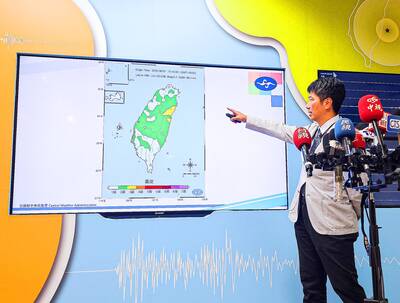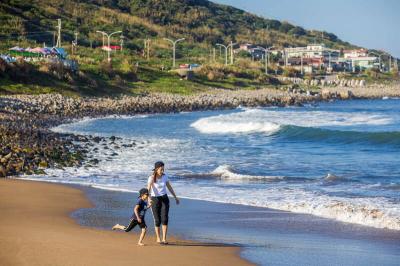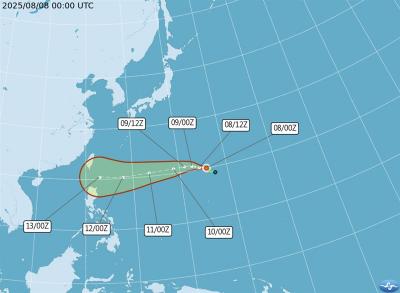A recent report on China’s nuclear weapons capabilities has re-ignited debate on the country’s nuclear policy and the overall lack of transparency surrounding the People’s Liberation Army (PLA).
In its China’s Nuclear Arsenal: Status and Evolution briefing paper released on Monday last week, the Union of Concerned Scientists (UCS) said the Chinese government had no intention of reaching numerical parity with the US on nuclear weapons and did not have the nuclear material to do so.
Released to coincide with the arrival of PLA Chief of General Staff Chen Bingde (陳炳德) in Washington, the paper said recent advances in China’s nuclear forces were intended to ensure the arsenal would survive an attack and preserve China’s ability to retaliate.
Beijing was not focused on increasing its offensive capability, it said, and its relatively small nuclear arsenal is solely for deterrent purposes.
“Some members of [US] Congress and the intelligence community overstate China’s nuclear capabilities and the scope of changes it is making to them,” said UCS China project manager Gregory Kulacki, who authored the paper. “Claims that China is rapidly modernizing its nuclear arsenal and seeks numerical parity with the United States are contradicted by the facts we can nail down about China’s nuclear arsenal.”
According to the report’s findings, China currently possesses an arsenal consisting of about 155 nuclear warheads ready to be deployed on six types of land-based missiles. It also said that limited stocks of plutonium “significantly constrain China’s ability to increase the size of its nuclear arsenal” and adds that “China’s focus is on improving its delivery systems to increase their survivability, and not on designing or developing new nuclear warheads.”
“China’s lack of nuclear testing since it signed the Comprehensive Nuclear Test Ban Treaty in 1996 restricts its ability to develop and deploy new, smaller warhead designs,” it says.
Seen as the latest salvo in an ongoing debate on China’s nuclear missile arsenal and strategy, the report has been met with some skepticism by defense experts, who say that the UCS may have underestimated the number of nuclear warheads in the PLA arsenal.
“Promoting continued nuclear weapons reductions is a core mission for the UCS, so making sure nobody ‘overestimates’ PLA nuclear capabilities and intentions — which of course the PLA seeks to keep as secret as possible — is a high priority for the Union as well,” Rick Fisher, a senior fellow at the International Assessment and Strategy Center in Washington, told the Taipei Times.
Kulacki’s insistence that the fundamental purpose of China’s nuclear arsenal is to prevent or counter foreign military coercion was simply wrong, Fisher said, adding that despite China’s declared “no first use” policy, there was “ample literature” and “PLA statements” pointing to a substantial coercive mission for China’s nuclear forces — especially as concerns a potential Taiwan contingency. It is believed by many experts that under certain circumstances, for example, China could detonate a nuclear device at high altitude to disrupt Taiwan’s electronic capabilities or destroy those of a carrier battle group at sea.
“This is why it is crucial that the US not get this wrong, and why it is critical that the US government be much more forthright about developing PLA strategic capabilities,” Fisher said. “The PLA is not going to tell us anything.”
Beyond a lack of transparency, which has haunted China’s relations with other countries on every aspect of its military, another problem with bean counting China’s nuclear arsenal derives from the metrics used for that assessment. As another specialist on the Chinese military told the Taipei Times, counting delivery vehicles alone is a limited basis for assessing the actual number of warheads.
The Second Artillery, which is responsible for China’s nuclear forces and also holds a large conventional missile arsenal, reportedly does not keep warheads mated with delivery vehicles in peacetime, and missile components are also believed to be stored separately.
China stores most warheads and/or warhead components at a central depot in the Qinling Mountains in Shaanxi Province. Each of the six missile bases has a warhead storage and handling facility, but there does not seem to be a permanent allocation of stored warheads, the analyst said. All of this makes it nearly impossible to assess the total number of warheads with certainty.
Furthermore, there reportedly has been substantial tunneling work at Qinling in the past decade and throughout the Second Artillery as a whole. It remains unclear, however, whether warhead depot-related tunneling work is for expansion purposes — in other words, to store more warheads — or just refurbishment.
Also not mentioned in the report is Chinese potential for nuclear capable land attack cruise missiles.
Another point of disagreement lies in the report’s contention that the DF-31 and DF-31A solid-fuel, long-range missiles China has -begun deploying in recent years to complement liquid-fuel missiles designed in the 1970s “cannot carry more than one of China’s smallest warheads.”
Asian sources maintain that the DF-31A and JL-2 missiles are expected to eventually have multiple warheads, and there are indicators that a variant of the DF-5 intercontinental ballistic missile (ICBM), which is believed to have been introduced in recent years, could come with multiple warheads. In Fisher’s view, Kulacki is downplaying Chinese interest in, and its ability to develop, multiple independent re-entry vehicle (MIRV) capabilities, which could result in a grossly underestimated total nuclear arsenal.
“The report also gives short treatment to the yet unnamed new large mobile ICBM we have been seeing in Internet source images since 2007,” Fisher said, adding that some of his sources had informed him this missile could carry as many as 10 warheads.
“With these two high potential MIRV missiles alone, the PLA has the potential to field hundreds of new warheads rather quickly if it so desires,” he said.
There has also been chatter on Chinese defense sites of advanced longer-range versions of the JL-2, as well as a possible JL-3 -submarine-launched ballistic missile for the anticipated Type 096 submarine, a potential addition to the Type 094 currently being built.
Another aspect of China’s military that is not fully taken into consideration in the report is the development of missile defense capabilities, a factor that could substantially increase Beijing’s ability to use nuclear blackmail over -Taiwan and in other contingencies.
Fisher said he also had doubts about the report’s contention that China had limited access to plutonium. Estimates of the size of China’s plutonium stock, the report says, are uncertain, but imply that the number of new warheads that could be produced from that stock would be limited, probably from “very few” to a “several hundred.”
However, while China has halted production of military plutonium, it has not declared an official moratorium. And while Beijing officially supports negotiations on a Fissile Material Cut-off Treaty that would ban all future production for weapons use, Chinese concerns about US missile defense systems have diminished its enthusiasm for the treaty, the UCS report said.
There are also reports that China recently began operating a pilot plant for reprocessing spent fuel rods from civilian nuclear reactors and operates an experimental fast breeder reactor. If it chose, China could divert plutonium from those two plants for weaponization, it said.
“How do we know there does not exist a separate underground PLA network for fissile production that we would likely never see? There is also the matter of the PLA deciding to make warheads with smaller amounts of fissile material, meaning any fixed amount can result in a greater number of warheads,” Fisher said.
Yet another factor could be technologies that enable more efficient use of available fissile material, he said, adding that lack of current, detailed information on China Academy of Engineering Physics research institutes and factories that could be actively involved in warhead-related work was another blind spot.

Aftershocks from a magnitude 6.2 earthquake that struck off Yilan County at 3:45pm yesterday could reach a magnitude of 5 to 5.5, the Central Weather Administration (CWA) said. Seismological Center technical officer Chiu Chun-ta (邱俊達) told a news conference that the epicenter of the temblor was more than 100km from Taiwan. Although predicted to measure between magnitude 5 and 5.5, the aftershocks would reach an intensity of 1 on Taiwan’s 7-tier scale, which gauges the actual effect of an earthquake, he said. The earthquake lasted longer in Taipei because the city is in a basin, he said. The quake’s epicenter was about 128.9km east-southeast

GENSLER SURVEY: ‘Economic infrastructure is not enough. A city needs to inspire pride, offer moments of joy and foster a sense of belonging,’ the company said Taipei was named the city with the “highest staying power” in the world by US-based design and architecture firm Gensler. The Taiwanese capital earned the top spot among 65 cities across six continents with 64 percent of Taipei respondents in a survey of 33,000 people saying they wanted to stay in the city. Rounding out the top five were Vietnam’s Ho Chi Minh City (61 percent), Singapore (59 percent), Sydney (58 percent) and Berlin (51 percent). Sixth to 10th place went to Monterrey, Mexico; Munich, Germany; Sao Paulo, Brazil; Vancouver; and Seoul. Cities in the US were ranked separately, with Minneapolis first at

The New Taipei City Government today warned about the often-overlooked dangers of playing in water, and recommended safe swimming destinations to cool off from the summer heat. The following locations in the city as safe and fun for those looking to enjoy the water: Chienshuiwan (淺水灣), Baishawan (白沙灣), Jhongjiao Bay (中角灣), Fulong Beach Resort (福隆海水浴場) and Sansia District’s (三峽) Dabao River (大豹溪), New Taipei City Tourism and Travel Department Director-General Yang Tsung-min (楊宗珉) said. Outdoor bodies of water have variables outside of human control, such as changing currents, differing elevations and environmental hazards, all of which can lead to accidents, Yang said. Sudden

Tropical Storm Podul has formed over waters north-northeast of Guam and is expected to approach the seas southeast of Taiwan next week, the Central Weather Administration (CWA) said today. The 11th Pacific storm of the year developed at 2am over waters about 2,660km east of Oluanpi (歐鑾鼻), Pingtung County — Taiwan's southernmost tip. It is projected to move westward and could have its most significant impact on Taiwan on Wednesday and Thursday next week, the CWA said. The agency did not rule out the possibility of issuing a sea warning at that time. According to the CWA's latest update, Podul is drifting west-northwest